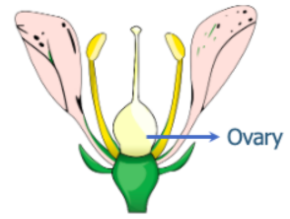Select Question Set:
Which of the following morphological features will not be seen in China rose?
1.

2.

3.

4.





Subtopic: Venation, Types of Leaves & Phyllotaxy | Flower & Parts of Flower |
55%
From NCERT
Please attempt this question first.
Hints
Please attempt this question first.
In the given diagram showing the structure of a monocotyledonous seed, identify the parts that are not correctly labelled?

1. Only A and B
2. Only A and C
3. Only B and D
4. A, B, C and D

1. Only A and B
2. Only A and C
3. Only B and D
4. A, B, C and D
Subtopic: Seed |
84%
From NCERT
Please attempt this question first.
Hints
Please attempt this question first.
Regarding tap root:
Statement I. The primary root and its branches constitute the tap root system.
Statement II. Tap roots of sweet potato get swollen and store food.
1. Only Statement II is correct
2. Both Statement I and Statement II are incorrect
3. Both Statement I and Statement II are correct
4. Only Statement I is correct
Statement I. The primary root and its branches constitute the tap root system.
Statement II. Tap roots of sweet potato get swollen and store food.
1. Only Statement II is correct
2. Both Statement I and Statement II are incorrect
3. Both Statement I and Statement II are correct
4. Only Statement I is correct
Subtopic: Morphology of Roots | Modification of Roots |
51%
From NCERT
Please attempt this question first.
Hints
Please attempt this question first.
Match each item in Column I [Type of placentation] with one in Column II [example] and select the correct match from the codes given:
Codes
| Column I | Column II | ||
| A. | Marginal | P. | Argemone |
| B. | Axile | Q. | Dianthus |
| C. | Parietal | R. | Pea |
| D. | Free central | S. | Lemon |
Codes
| A | B | C | D | |
| 1. | P | S | Q | P |
| 2. | S | R | P | Q |
| 3. | R | S | P | Q |
| 4. | S | R | Q | P |
Subtopic: Flower & Parts of Flower |
87%
From NCERT
Please attempt this question first.
Hints
Please attempt this question first.
Epitepalous stamens are seen in:
1. Asparagus
2. Petunia
3. Ashwagandha
4. Sesbania
1. Asparagus
2. Petunia
3. Ashwagandha
4. Sesbania
Subtopic: Semi Technical Description | Families of Flowering Plant |
53%
From NCERT
Please attempt this question first.
Hints
Please attempt this question first.
Among flowers of Calotropis, tulip, Sesbania, Asparagus, Colchicine, Sweet pea, Petunia, Indigofera, Mustard, Soybean, Tobacco and groundnut how many plants have corolla with valvate aestivation?
| 1. | Six | 2. | Seven |
| 3. | Eight | 4. | Five |
Subtopic: Flower & Parts of Flower |
From NCERT
NEET - 2013
Please attempt this question first.
Hints
Please attempt this question first.
Inflorescence is racemose in:
1. Brinjal
2. Tulip
3. Aloe
4. Soybean
1. Brinjal
2. Tulip
3. Aloe
4. Soybean
Subtopic: Families of Flowering Plant |
57%
NEET - 2013
Please attempt this question first.
Hints
Please attempt this question first.
The viability of seeds is tested by:
1. 2, 6 dichlorophenol indophenols
2. 2, 3, 5 triphenyl tetrazolium chloride
3. DMSO
4. Safranine
1. 2, 6 dichlorophenol indophenols
2. 2, 3, 5 triphenyl tetrazolium chloride
3. DMSO
4. Safranine
Subtopic: Seed |
NEET - 2013
Please attempt this question first.
Hints
In a cymose inflorescence, the main axis:
| 1. | has unlimited growth |
| 2. | bears a solitary flower |
| 3. | has unlimited growth but lateral branches end in flowers |
| 4. | terminates in a flower |
Subtopic: Inflorescence |
77%
From NCERT
NEET - 2013
Please attempt this question first.
Hints
Please attempt this question first.
How many plants among China rose, Ocimum, sunflower, mustard, Alstonia, guava, Calotropis and Nerium (Oleander) have opposite phyllotaxy?
1. Three
2. Four
3. Five
4. Two
1. Three
2. Four
3. Five
4. Two
Subtopic: Venation, Types of Leaves & Phyllotaxy |
NEET - 2013
Please attempt this question first.
Hints
Select Question Set:


